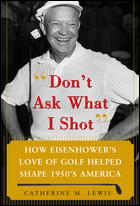Ike and golf subject of new history
September 14, 2007
For Baby Boomers and those from subsequent generations not even born at the time, the American 1950s can be a hazy combination of conflicting images.
For every flashback to the Honeymooners and Milton Berle, there are memories of the Korean War and Joe McCarthy. For every reminder of the vast post-war suburban migration out of America’s cities, there are visions of H-Bomb tests and duck-and-cover drills.
Nonetheless, President Dwight D. Eisenhower remains one of the common reassuring themes of the era. Despite the dangers then facing the country from the outside, such as Communist China and the Soviet Union, and the domestic difficulties of recovering from the wartime economy of the 1940s, Eisenhower was a calming influence on the nation he led for two terms.
His contribution to America for that fact alone should be better appreciated than it has been–and in fact, recent historical scholarship has been far kinder to the old general than it was in the immediate aftermath of the Kennedy era.
Don’t Ask What I Shot: How Eisenhower’s Love of Golf Helped Shape 1950s America is a new contribution to this viewpoint (McGraw-Hill; $24.95).
Catherine M. Lewis’ study of that frequently troubled time takes a golf-oriented approach in support of this renewed appreciation for Ike’s contributions. For example, Eisenhower’s frequently cheerful manner is captured on the front cover of the book, with a charming photograph of a beaming Ike holding a driver in his right hand.
Lewis charts the parallel history of American golf in the early 20th century with Eisenhower’s personal story–raised in modest circumstances in Texas and the Midwest, graduating from West Point, and becoming the leading Allied general in World War II. She also correctly notes golf’s upper-class orientation in this country during this time, along with the rise of the professional golf tour.
Eisenhower first learned the game as a young officer, and became an avid though not highly skilled player. His golfing addiction continued during the war, as reflected in an amusing apocryphal story about a creative use of ordnance to build a sand bunker.
As with U.S. Grant after the Civil War, Eisenhower seemed a natural choice for the presidency after the U.S.-led victory over Germany and Japan. That option did not seem quite so natural to Eisenhower, at first. Nonetheless, Lewis recounts how a group of highly influential leaders built up the nerve to push Ike toward the Republican nomination and a win over Adlai Stevenson in 1952.
Lewis also shows how golf was a critical connecting point between Ike and these leaders, especially among the carefully chosen members of Augusta National, and particularly the club’s chairman, Clifford Roberts.
In many ways, the story of Eisenhower and golf is the story of the increasing influence of Augusta National’s members during the 1950s, only 15 years or so after Bobby Jones and Roberts began their now-famous major tournament. Eisenhower loved playing there, and Lewis details the large web of connections between the President and the club.
Eisenhower’s friendship with Arnold Palmer, cemented by their mutual love for Augusta National, also helped spur a wider interest in golf far beyond it’s upper-class origins in America. That connection perhaps best exemplifies Eisenhower’s contribution to American society through his love of golf. He significantly broadened golf’s appeal, at a time when the new medium of television brought the sport into millions of living rooms. His obvious joy at playing the game was simply infectious.
This book is a valuable addition to the social history of modern America. My only quibble is that Lewis could have been helped with a bit more editing, as some sections are a bit repetitive.


